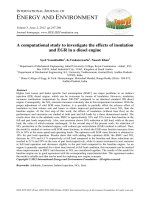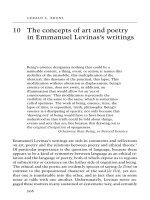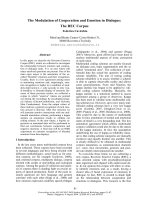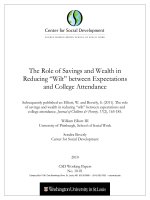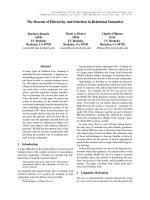The concepts of art and poetry in Emmanuel Levinas’s writings
Bạn đang xem bản rút gọn của tài liệu. Xem và tải ngay bản đầy đủ của tài liệu tại đây (231.41 KB, 28 trang )
gerald l. bruns
10 The concepts of art and poetry
in Emmanuel Levinas’s writings
Being’s essence designates nothing that could be a
nameable content, a thing, event, or action; it names this
mobility of the immobile, this multiplication of the
identical, this diastasis of the punctual, this lapse. This
modification without alteration or displacement, being’s
essence or time,
does not await, in addition, an
illumination that would allow for an ‘act of
consciousness.’ This modification is precisely the
visibility of the same to the same, which is sometimes
called openness. The workof being, essence, time, the
lapse of time, is exposition, truth, philosophy. Being’s
essence is a dissipating of opacity, not only because this
‘drawing out’ of being would have to have been first
understood so that truth could be told about things,
events and acts that are; but because this drawing out is
the original dissipation of opaqueness.
Otherwise than Being, or Beyond Essence
Emmanuel Levinas’s writings are rich in comments and reflections
on art, poetry and the relations between poetry and ethical theory.
1
Of particular importance is the question of language, because there
appears to be a kind of symmetry between language as an ethical re-
lation
and the language of poetry, both of which expose us to regions
of subjectivity or existence on the hither side of cognition and being.
The ethical and the poetic are evidently species of saying (le Dire)in
contrast to the propositional character of the said (le Dit), yet nei-
ther one is translatable into the other, and in fact they are in some
sense at odds with one another. Unfortunately, Levinas never en-
gaged these matters in any sustained or systematic way, and certainly
206
Art and poetry in Levinas 207
never without confusion. His friend Maurice Blanchot observed in
an early essay that ‘Levinas mistrusts poems and poetic activity’.
2
But it is also clear that Levinas could not get such things out of his
mind, for he frequently found in poetry and art conceptual resources
for his thinking, which perhaps helps to explain why the ethical in
his workis never far removed from the aesthetic. But aesthetic in
what sense? My purpose here will be to construct as coherent an ac-
count as I can of the place and importance that poetry and art have
in Levinas’s thinking. This account will have three goals. The first
will be to sort
out, so far as possible, Levinas
’s often contradictory
statements about art. The second will be to clarify the difference be-
tween two conceptions of the aesthetic at workin Levinas’s writings,
which I will call an aesthetics of materiality and an aesthetics of the
visible. The argument here will be that, although Levinas found it
difficult to distinguish these two conceptions, or did
not want to
choose between them, his account of the materiality of the work
of art is an important contribution to modernist aesthetics for the
way it articulates the ontological significance of modern art and its
breakwith the aesthetics of form and beauty that comes down to
us from classical tradition and from Kant. Modern art is no longer
an art of the visible (which is why it is difficult for most people to
see it as art). Possibly we will be able to say that in Levinas both
materiality and the beautiful are reinterpreted in terms of the prox-
imity of things, taking proximity to be something like an alternative
to visibility. The third aim of this enquiry will be to come to some
understanding of the relationship between poetry and the ethical as
analogous forms of transcendence in the special sense that Levinas
gives to this term. The argument here will be that, if ‘Being’s essence
is a dissipating of opacity’ (
ob
30), poetry is a ‘darkening of being’
(
cp
9), a thickening, temporalization or desynchronizing of essence
that occurs alongside the ethical, if not in advance of it, as ‘an
unheard-of modality of the otherwise than being’ (
pn
46).
poetics ancient and modern
In order to make my account precise and meaningful, however, it
will be helpful to have a rough sense of where Levinas appears within
poetry’s conceptual history, starting perhaps with the early years of
modernity when German and British romantics pressed the question
208 the cambridge companion to levinas
of what sort of thing poetry might be if it is not (as both ancient and
medieval traditions of poetics had taught) a form of mediation in the
service of other fields of discourse – namely, the versifying of mean-
ings derived from various contexts of learning, or the rehearsal of
traditional themes of religious and erotic experience.
3
Arguably the
great achievement of modernity was not only the development of sci-
entific reason but also the invention of a concept of art that, what-
ever its philosophical difficulties, provided a space for speculation
in which such a thing as poetry could become (and remain) a ques-
tion for itself – an event that Arthur Danto, interpreting a famous
line from Hegel, has characterized as ‘the end of art’, or the moment
when art and poetry turn self-reflexively into philosophy.
4
For what
is distinctive about romantic poetics is that it is no longer concerned
simply with the art of composing verses but becomes an enquiry into
the nature of poetry and the conditions that make it possible. So
Friedrich Schlegel (1772–1829), for example, calls modern poetry a
Transzendentalpoesie that combines the traditional ‘self-mirroring’
of the lyrical poet with ‘the transcendental raw materials and prelim-
inaries of a theory of poetic creativity [Dichtungsverm
¨
ogens]’: ‘In all
its descriptions, this poetry should describe itself, and always be si-
multaneously poetry and the poetry of poetry.’
5
As if modern poetry
were now become the experience of poetry as such, quite apart from
the significance or utility it might still have for the church, the court
and the schools.
This is not to say that the classical tradition did not have a pro-
found understanding of the nature (and difficulty) of poetry. For ex-
ample, the ancients typically regarded poetry as an instance of the
darksaying, the ainigma, a word that sometimes gets translated as
riddle; but unlike a riddle, the enigma’s darkness is not something
that can be illuminated, or eliminated, by reason or interpretation. It
is not a puzzle whose solution justifies its formulation but is opaque
in the nature of the case, and to that extent it defines the limits of
the discursive regions that we inhabit. Poetry is anarchic in the orig-
inal sense of the word. In the Republic Plato formalized this link
between poetry and anarchy (and, in the bargain, instituted the dis-
cipline of philosophy) when he charged that poetry is not something
that can give itself a reason but is exemplary of all that is incoherent
with the just and rational order of things, that is, the order of the
, where ideally everything manifests (from within itself) the
Art and poetry in Levinas 209
reason why it is so and not otherwise. Following Plato – or, in the
event, Aristotle, who found a place for poetry in his organon or rule
of discourse by reconceptualizing it both as a species of cognition
(mimesis) and as a kind of consecutive reasoning (plot) – the justi-
fication of poetry became the traditional taskof allegory, which is
a philosophical way of reading non-philosophical texts by constru-
ing them so as to make them coherent with prevailing true beliefs.
Henceforward poetry could only justify itself by celebrating or sup-
plementing conceptual worlds already in place. But taken by itself,
the poetic text remains exotic in the etymological sense – dense,
refractory to the light, not a part o
f but
a limit of the world and
its reasons – which is perhaps why the classical tradition in poetics
has always been concerned to the point of obsession with rules for
keeping poetry under rational control.
In the late nineteenth century the French poet St
´
ephane Mallarm
´
e
(1842–1898) renewed this enigmatic tradition for modernity with
his famous remark, ‘My dear Degas, one does not make poetr
y with
ideas, but with words.’ Whereas the romantics had conceptualized
poetry as a mode of experience or subjectivity, Mallarm
´
e was the
first to conceptualize poetry in terms of language. Indeed, Mallarm
´
e
can be said to have inaugurated the radical thesis of literary mod-
ernism, namely that a poetic workis made of language but not of
any of the things that we use language to produce – meanings, con-
cepts, propositions about the world, expressions of feeling, etc. Not
that the poem excludes these things, but it is no longer reducible to
any of them because in poetry the materiality of language is now re-
garded as essential, no longer part of a distinction of letter and spirit
but now the essence of poetry as such. For Mallarm
´
e, poetry is made
of writing (l’
´
ecriture), so that the basic units of the poem include
not only the letters of the alphabet but also the white space of the
printed page, the fold in its middle, and the typographical arrange-
ments that the letters inscribe.
6
So poetry is not a form of mediation
that brings something other than itself into view (not allegory or
symbol). On the contrary, Mallarm
´
e distinguished poetry from in-
formative, descriptive and symbolic uses of language by claiming for
the materiality of poetic language the power to obliterate the world of
objects and events: ‘When I say, “a flower!” then from that forgetful-
ness to which my voice consigns all floral form, something different
from the usual calyces arises ...the flower which is absent from all
210 the cambridge companion to levinas
bouquets’ (
oc
356). Writing on Mallarm
´
ein1942 Maurice Blanchot
glossed this famous line by explaining that in its propositional form
language
destroys the world to make it reborn in a state of meaning, of signified
values; but, under its creative form, it fixes only on the negative aspect of
its taskand becomes the pure power of questioning and transfiguration. That
is possible insofar as, taking on a tangible quality, it becomes a thing, a body,
an incarnate power. The real presence and material affirmation of language
gives it the ability to suspend and dismiss the world.
7
What this means is that poetic language is not just an inert mass,
not merely a blankor opaque aesthetic ‘veil of words’; rather it is a
discursive event that interrupts the logical
or dialectical movement
of signification and thereby opens up a dimension of exteriority or
worldlessness – a world without things, or perhaps one should say:
things free of the world.
the ontological significance of
the materiality of art
Emmanuel Levinas’s earliest writings on art and poetry should be
read against the background of the resurgence of interest in Mallarm
´
e
that began with the publication of Henri Mondor’s Vie de Mallarm
´
e
in 1941 and Blanchot’s critical appropriation of Mallarm
´
e’s poetics
during this same period, which served to sharpen differences among
an array of positions in the controversies about the social significance
of art that erupted in Paris following the Liberation.
8
For example, in
a series of essays published in 1947 in Les temps modernes, Jean-Paul
Sartre elucidated his theory of writing as a form of social action by
opposing it to poetry conceived explicitly in Mallarm
´
ean terms as the
workof ‘men who refuse to utilize language’.
9
The poet, Sartre says,
‘is outside language’, on ‘the reverse side of words’, which he treats
as mere things to be assembled the way Picasso constructs a collage
(
s
64–6/
wl
30–1). Meanwhile the prose writer is situated ‘inside of
language’, which he manipulates as an instrument for grasping the
world. In prose, words become actions, but poetry for Sartre is the
‘autodestruction’ of language, whose economy is no longer restricted
to the exchange of meanings and the production of rhetorical effects
but is now an opaque, thinglike thing (
s
70–2/
wl
35–7).
10
Art and poetry in Levinas 211
In 1947 Levinas published De l’existence
`
a l’existant, a series
of studies of what might be called, after Georges Bataille, ‘limit-
experiences’, that is, experiences (fatigue, insomina, the experience
of art) that are irreducible to categories of cognition and whose anal-
yses serve as a way of exploring subjectivity beyond the limits of
conventional phenomenology. In the section entitled ‘Existence sans
existant’ Levinas takes recourse to Mallarm
´
ean aesthetics as a way of
introducing the concept of the ilya– if ‘concept’ is the word, since
the term is meant to suggest the possibility of existence without
existents, a pure exteriority of being without appearance, and thus a
phenomenology without phenomena. As Levinas figures it, the work
of art (by which Levinas, in this context, means the modern artwork)
opens up this possibility of existence without being because it makes
everyday things present by ‘extracting [them] from the perspective
of the world’, where the world is that which comes into being as
a correlate of intentionality, cognition or conceptual determination
(
ee
52). The idea is that in art our relation to things is no longer
one of knowing and making visible. Art does not represent
things, it
materializes them; or, as Levinas would prefer, it presents things in
their materiality and not as representations. It is clear that Levinas
is thinking of the work of the workof art as something very different
from the workof intentional consciousness, and this is a difference
that enables him to formulate in a new way the fundamental ques-
tion of modernist aesthetics: ‘What becomes of things in art?’ It is not
enough (or even accurate) to say that modern art repudiates mimesis,
representation or realism in order to purify itself of everything that
is not art – the so-called doctrine of ‘aesthetic differentiation’ that
figures art as a pure workof the spirit.
11
Levinas speaks rather of ‘the
quest of modern painting and poetry to banish ...that soul to which
the visible forms were subjected, and to remove from represented ob-
jects their servile function as expressions’ (
ee
55). This ‘banishment
of the soul’ means, whatever else it means, that the modern workof
art cannot be thought of as just another ideal object that conscious-
ness constructs for itself – a non-mimetic or purely formal object,
one determined by traditional canons of beauty; on the contrary, the
workis now defined precisely as a limit of consciousness: ‘Its inten-
tion is to present reality as it is in itself, after the world has
come
to an end’ (
ee
56), as if on the hither side (en dec¸a) of the world that
consciousness represents to itself. On this analysis modern art can
212 the cambridge companion to levinas
no longer be conceived as an art of the visible. ‘Paradoxically as it
may seem’, Levinas says,
painting is a struggle with sight. Sight seeks to draw out of the light beings
integrated into a whole. To lookis to be able to describe curves, to sketch
out wholes in which the elements can be integrated, horizons in which the
particular comes to appear by abdicating its particularity. In contemporary
painting things no longer count as elements in a universal order ...The par-
ticular stands out in the nakedness of its being [
ee
56]
This emancipation
of singularity from the reduction to an order of
things is the essence of Cubism, whose break-up of lines of sight
materializes things in a radical way:
From a space without horizons, things breakaway and are cast toward us
like chunks that have weight in themselves, blocks, cubes, planes, trian-
gles, without transitions between them. They are naked elements, simple
and absolute, swellings or abscesses of being. In this falling of things down
on us objects attest their power as material objects, even reach a paroxysm
of materiality. Despite the rationality and luminosity of these forms when
taken in themselves, a painting makes them exist in themselves [le tableau
accomplit l’en-soi m
ˆ
eme de leur existence], brings about an absolute ex-
istence in the very fact that there is something which is not in its turn
an object or a name, which is unnameable and can only appear in poetry.
[
ee
56–7]
The idea is that in Cubism the spectator can no longer objectify what
he or she sees; the workis no longer visible in the way the world is.
For Levinas this means that the materiality of the workof art can
no longer be contrasted with form or spirit; it is pure exteriority,
uncorrelated with any interior
, and therefore it constitutes a kind
of transcendence (note that it ‘can only appear in poetry’). ‘For here
materiality is thickness, coarseness, massiveness, wretchedness. It
is what has consistency, weight, is absurd, is a brute but impassive
presence; it is also what is humble, bare, and ugly’ (
ee
57). For Levinas,
the materiality of the workof art is just this implacable ‘materiality
of being’, where ‘matter is the very fact of the ilya’(
ee
57). What
Levinas wants to know is (and this is evidently the source of his
interest in the workof art): What is ‘the ontological significance of
materiality itself’? (
cp
8).
Art and poetry in Levinas 213
the experience of art
Part of this significance emerges when one asks what happens to
subjectivity in the encounter with the workof art. What is it to be
involved – or, as Levinas prefers, what is it to participate – in the mo-
ment when the workof art frees things from the conceptual grasp of
the subject and returns them to the brute materiality of existence?
The point to markhere is that for Levinas the experience of poetr
y
or art is continuous with the experience of the ilya, which De
l’existence
`
a l’existant describes as an experience of a world emptied
of its objects. One has to imagine inhabiting a space that is no longer
a lifeworld, as if ‘after the world has come to an end’. (In Totalit
´
eet
infini Levinas writes: ‘When reduced to pure and naked existence,
like the existence of the shades Ulysses visits in Hades, life dissolves
into a shadow’ (
ti
112).) Levinas figures this experience of exterior-
ity in terms of insomnia and the interminability of the night, as well
as in terms of certain kinds of mystical or magical events in which
subjectivity loses itself in an impersonal alterity, but he also com-
pares it to certain kinds of realistic or naturalistic fiction in which
‘beings and things that collapse into their “materiality” are terrify-
ingly present in their density, weight and shape’ (
ee
59–60). Things
present in their materiality (like things in the night) are invisible, un-
graspable – and horrible, where horror is not just a psychic tremor but
a kind of ontological ecstasy, a movement that ‘turns the subjectivity
of the subject, his particularity qua entity, inside out’ (
ee
61), thus ex-
posing it to ‘the impersonal, non-substantive event of the night and
the il y a’(
ee
63). This same ontological ecstasy is what characterizes
the experience of the workof art, which on Levinas’s analysis can
never be an aesthetic object – never just something over and against
which we can maintain the disinterested repose of the connoisseur;
rather, disturbance and restlessness are the consequences of art. The
experience of modern art is no longer intelligible from the standpoint
of an aesthetics of beauty, with its premium upon the integration of
discordant elements into a whole. Modern art, with its premium on
the fragmentary, is an art of derangement; it does not produce har-
mony and repose but dissonance and anxiety (thinkof the noise of
the dada drummer).
12
This is part of what it means to say that mod-
ern art is no longer an art of the visible. Indeed, Levinas’s analysis
opens up what one might call the ‘non-aesthetic’ dimension of the
214 the cambridge companion to levinas
workof art; or, put differently, Levinasian aesthetics is an aesthet-
ics of darkness rather than of light, of materiality as against spirit
(or, more accurately, an aesthetics of materiality that is prior to the
alternatives of matter and spirit).
Darkness is the thesis of ‘Realit
´
e et son ombre’ (1948), which be-
gins by stipulating that the workof art is, contra the Aristotelian
tradition, outside all categories of cognition and representation –
outside the light and the visible: ‘It is the very event of obscuring, a
descent of the night, an invasion of shadow. To put it in theological
terms ...art does not belong to the order of revelation’ (
cp
3). To be
sure, a workof art is made of images, but an image is not (as in tra-
ditional
aesthetics, or in Sartre
’s theor
y) a form of mediation; on the
contrary, it constitutes a limit and, indeed, a critique of experience
and therefore of subjectivity as such. Levinas writes: ‘An image does
not engender a conception, as do scientific cognition and truth ...An
image marks a hold over us rather than our initiative: a fundamental
passivity’ (
cp
3).
13
An image works like a rhythm, which
represents a unique situation where we cannot speakof consent, assump-
tion, initiative or freedom, because the subject is caught up and carried away
by it ...It is so not even despite itself, for in rhythm there is no longer a
oneself, but rather a sort of passage from oneself to anonymity. This is the
captivation or incantation of poetry and music. It is a mode of being to which
applies neither the form of consciousness, since the I is there stripped of its
prerogative to assume, its power, nor the form of unconsciousness, since the
whole situation and all its articulations are in a darklight, present.[
cp
4]
This conversion to anonymity means simply that art turns the so-
vereign
ego out of its house in a deposition that anticipates the
trauma or obsession of the ethical relation.
14
In the experience of the
image, Levinas says, the subject is no longer a ‘being in the world’ –
especially since ‘What is today called “being-in-the-world” is an exis-
tence with concepts’ (
cp
5), with all that this entails in the metaphor
of grasping things and laying them open to view (
cp
3). The image
implies a reversal of power that turns the subject into a being ‘among
things’, wandering ‘among things as a thing, as part of the spectacle.
It is exterior to itself, but with an exterior which is not that of a body,
since the pain of the I-actor is felt by the I-spectator, although not
through compassion. Here we have really an exteriority of the in-
ward’ (
cp
4).
15
Here (as in Blanchot’s poetics) the subject is no longer
Art and poetry in Levinas 215
an ‘I’ but a ‘he’ – or, as the French more accurately has it, an il: he/it,
neither one nor the other (neutral, anonymous). The interior of the
subject has been evacuated; the subject is no longer correlative with
a world but is, so to speak, outside of it. Perhaps one should say:
exposed to it.
16
At any rate the experience of the image is not an intentional ex-
perience: the image is not an image of something, as if it were an
extension of consciousness, a light unto the world. Phenomenology
is mistaken, Levinas says, when it insists on the ‘transparency’ of im-
ages, as if images were signs or symbols, that is, logical expressions
of subjectivity – products of ‘imagination’, for example, supposing
there to be such a thing (
cp
5). But images do not come into being
according to a logic of mental operations, say by way of comparisons
with an original. On the contrary, every original is already its own
image:
Being is not only itself, it escapes itself. Here is a person who is what he is; but
he does not make us forget, does not absorb, cover over entirely the objects he
holds and the way he holds them, his gestures, limbs, gaze, thought, skin,
which escape from under the identity of his substance, which like a torn
sackis unable to contain them. Thus a person bears on his face, along side
of its being with which he coincides, its own caricature, its picturesqueness.
The picturesque is always to some extent a caricature. Here is a familiar
everyday thing, perfectly adapted to the hand which is accustomed to it, but
its qualities, colour, form, and position at the same time remain as it were
behind its being, like the ‘old garments’ of a soul which had withdrawn from
that thing, like a ‘still life’. And yet all this is the person
and is the thing.
There is then a duality in this person, this thing, a duality in being. It is
what it is and is a stranger to itself, and there is a relationship between these
two moments. We will say the thing is itself and is its image. And that this
relationship between the thing and its image is resemblance. [
cp
6]
An image is, so to speak, not a piece of consciousness but a piece
of the ilya: it is a materialization of being, the way a cadaver is
the image of the deceased, a remainder or material excess of being:
‘the remains’.
17
Levinas writes: ‘A being is that which is, that which
reveals itself in its truth, and, at the same time, it resembles itself, is
its own image. The original gives itself as though it were at a distance
from itself, as though it were withdrawing from itself, as though
something in a being delayed behind being’ (
cp
6–7). An image is
not a reproduction of a thing but (as in Mallarm
´
e) a withdrawal of it
216 the cambridge companion to levinas
from the world; consciousness is stopped in its tracks by an image
and cannot get round behind it to an originating intention that would
transform it into a meaning (a symbol or stand-in). Thus a painting is
not, pace phenomenology, a looking-glass on to another world: ‘The
painting does not lead us beyond the given reality, but somehow to
the hither side of it. It is a symbol in reverse’ (
cp
7). A ‘symbol in
reverse’ means that the gaze of the spectator stops at the surface of
the painting and is, so to speak, held there, on the hither side of
being, suddenly passive, no longer seeing but gripped by what it sees
in an ecstasy of fascination. The image no longer belongs to the order
of the visible. ‘It belongs to an ontological dimension that does not
extend between us and a reality to be captured, a dimension where
commerce with reality is a rhythm’ (
cp
5).
the work of art as a modality
of transcendence
What is the significance of this dimension – this irrealit
´
e or material-
ity of being (
cp
8)? This question leads in several directions. The work
of art is not a mode of revelation but a mode of transcendence – or, as
Levinas says (borrowing from Jean Wahl), transdescendence (
cp
8):
in art reality is beside itself, on the hither side of itself, materialized,
no longer an object for us but a thing in itself, a pure exteriority.
Basically, art is ecstasy. In the third section of ‘Realit
´
e et son ombre’
Levinas figures this ecstasy or exteriority temporally as an interrup-
tion of being: the entre-temps, the meanwhile in which the present
is no longer a traversal or evanescence but an interval that separates
the past from the future, as in the interminability of the statue, or
in the fate of the tragic hero for whom the catastrophe has always
already occurred:
Art brings about just this duration in the interval, in that sphere which a
being is able to traverse, but in which its shadow is immobilized.
The eternal
duration of the interval in which a statue is immobilized differs radically
from the eternity of the concept; it is the meanwhile, never finished, still
enduring – something inhuman and monstrous. [
cp
11]
To experience art is to enter into this ‘inhuman or monstrous’ entre-
temps, which is not a ‘now’ but an event that interrupts what is
happening in the way insomnia keeps the night from passing in sleep,
